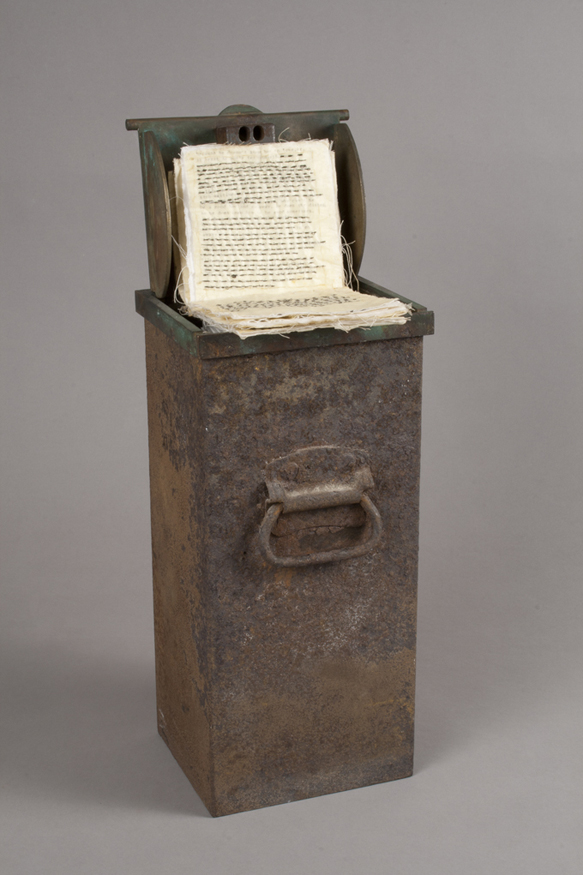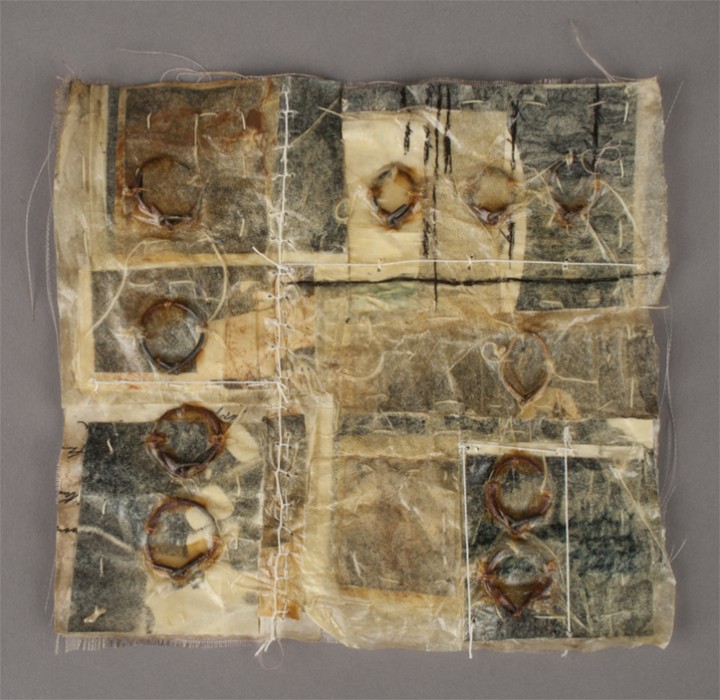
Kry Bastian’s work occupies the liminal space that all effective art does: between the private and the public, the familiar and the strange. Artworks that cannot move beyond the individual become self-indulgent or irrelevant, but those that attempt to speak universally without the imprint of their makers often fall into predictability and cliché; every inhabitant of this threshold balances the relationship in its own way. Bastian has exposed the infrastructure of the two objects under consideration here, Untitled (Safe II) (1994) and Our Work(1997), which cohere into a case study of this dialectic—they simultaneously present intimacy and distance by “weaving together the known/recollected present with an imagined past.”1
The pieces are personal in size, the dimensions of human objects. Untitled (Safe II) stands just shy of two feet tall and could be a bedside object, and the browned panels of Our Work measure about five inches on each side, curling up like warped old family photographs. They do not announce themselves as Artworks, monuments to the artist’s Genius to be installed in the foyer of a museum or on the wall of a corporate office, but rather invite the viewer in with restraint, rewarding subtlety and attentiveness.

Each piece is assembled from familiar components, including fabric, ink, thread, and metal; these found materials are gathered by Bastian and “live in [her] space for a time until they need to become something else.”2 The rusted metal receptacle of Untitled (Safe II) holds multiple book-like objects, constructed of fabric pages sewn together and encased in thin paper. An earlier iteration, Untitled (Safe I), failed at its ostensible purpose, its contents cascading out of it and spilling onto the floor. The valuables of this second “safe” have been contained and protected, even from our eyes. Our Work, created just a few years later, is an exploded variant of Untitled (Safe II). The pages are no longer bound, but stacked and spread; no longer secure, but visible to all and vulnerable to the whims of the wind. Each square is an accretion of fabric and paper, with steel rings that sometimes puncture the thin upper skin and handwritten lines that face all directions and are frequently crossed-out. None of these layers are discrete. They are physical representations of Bastian’s process of excavating history and then re-forming it—layered and re-layered rock strata. (The artist has remarked that the history is often her own.3)
While the formal qualities of these artworks render them intimate—the found materials, the personal size, the handwritten lines—in their conceptual conclusion Bastian provides the distance of ambiguity. Untitled (Safe II) and Our Work are tantalizing, teasing even, as they simultaneously present and withhold. Looking into Untitled (Safe II) evokes the experience of approaching a tunnel, when what is nearest is prominently clear, and what is immediately beyond is obscured in darkness; a peek under the visible book reveals that it sits on top of a pile of similar volumes bound together in stacks by wire, delicate and inaccessible. The typed text inside (we assume each volume but can only verify the first), which forms a compilation of letters or journal entries, is repeatedly sewn through with a tightly controlled running stitch.

The opening line of the displayed book, Dear indifference, promptly signals that we will not be provided with the explanations that, as Bastian points out, we have come to expect from text4: the epithet is ambiguous on its own, and crossed out provides even more space for uncertainty. As in the bound and unreachable volumes of Untitled (Safe II), the lines we can decipher on the panels of Our Workare often crossed off or pasted over, containing meaning but hindering our apprehension of it. In both of these works the words that would purport to grant understanding are purposefully displayed but conspicuously insufficient; text that, as the artist interprets it, “varies in legibility…surfaces and recedes as a voice might.”5
So much of what I’ve written about Bastian’s work could imply that it is exasperating, but the artist’s intention is to frustrate, not to make us frustrated. She acknowledges the presenting-yet-withholding nature of the work: “just as walking into an old house or coming upon an old object gives us the sense of knowing or familiarity while simultaneously remaining a mystery, so does my work reveal and veil itself at the same time.”6 But this revealing and veiling is meant to open up one’s experience of the art, not to impede it. When asked whether the dual nature in her works is intended to obstruct or simply appears that way as a byproduct of the human imperative to understand, the artist responds that such a situation is “the definition of what memory is—a sometimes blurry piecing together of what we believe has occurred.”7 And it is perhaps this reference to memory that encapsulates the works’ positioning vis-à-vis the binary dialectics of public/private and intimate/strange. Memory dwells in the same stratum as dreams. It is personal, providing a varied, emotion-laden, and unique construction of a series of events or experiences, but also somewhat unknowable, being vulnerable to influence, time’s murkiness, and self-corrective rationalization. The conglomerate character of memory renders it both individual and corporate, a thing-created while a thing-being-created. In these works Bastian has captured the uncanny sensation of déjà vu, that mysterious recognition, and the compelling expression of her objects ultimately emerges from the realization that their past—familiar yet strange—could be ours.
1. Kry Bastian, e-mail message to author, 12 July 2011.
2. Ibid.
3. Ibid.
4. Ibid.
5. Kry Bastian, “Statement,” accessed 17 July 2011, http://www.krybastian.com/statement.aspx.
6. Kry Bastian, e-mail message to author, 12 July 2011.
7. Ibid. Emphasis original.
Kry Bastian Biography